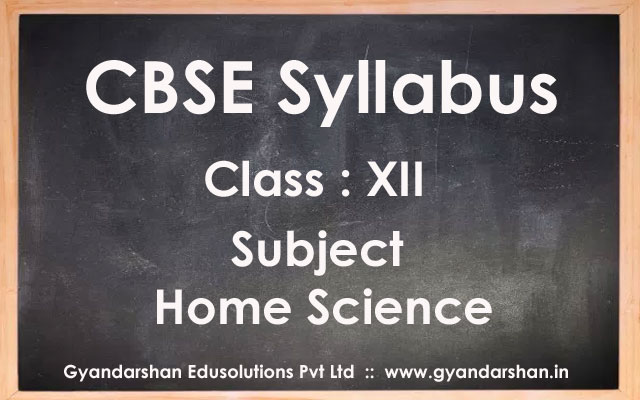
Home Science Class XII Syllabus
Exam Structure
| Unit | Chapter | Marks |
| I | Human Development: Life Span Approach (Part II) | 30 |
| II | Nutrition for Self, Family and Community | |
| III | Money Management and Consumer Education | 35 |
| IV | Apparel: Designing, Selection and Case | |
| V | Community Development and Extension (Part II) | 5 |
| VI | Career Option after Home Science Education | |
| Practical | 30 | |
| Total | 100 |
Unit I: Human Development: Life Span Approach (Part II)
A. Adolescence (12 – 18 years)
(i) Growth & Development – Domains and principles.
(ii) Meaning, characteristics and needs.
(iii) Influences on identity formation
- (a) Biological and Physical changes-early and late matures. (Role of heredity and environment)
- (b) Social, culture and media.
- (c) Emotional changes.
- (d) Cognitive changes.
(iv) Specific issues and concerns
- (a) Eating disorders-Causes, consequences and management – Anorexia Nervosa, Bulimia.
- (b) Depression
- (c) Substance Abuse
- (d) Related to sex
- (e) Handling stress and peer pressure
B. Adulthood:
(i) Young & middle adulthood: Understanding and management of new responsibilities, carrier marriage and family.
(ii) Late Adulthood/Old age:
- (a) Health and Wellness: physical, social, emotional, financial, recreational needs
- (b) Care for elderly (at home and outside – old age home)
- (c) Anger management
Unit II: Nutrition for Self, Family and Community
(a) Meal Planning: Meaning and importance, principles and factors affecting meal planning; Nutritional needs, food preferences and modifications of diets in different age groups: infants, children, adolescence, adults, elderly and in special conditions: pregnancy and lactation (including traditional foods given in these conditions)
- (i) Use of basic food groups (ICMR) and serving size in meal planning
- (ii) Factors influencing selection of food: culture, family food practices, media, peer group, availability of foods, purchasing power, individual preference & health.
(b) Food safety and quality:
- (i) Safe food handling (personal, storage, kitchen, cooking and serving).
- (ii) Safety guards against food adulteration, definition and meaning of food adulteration as given by FSSAI (Food Safety and Standard Authority of India).
- (iii) Common adulterants present in cereals, pulses, milk and milk products, fats and oils, sugar, jaggery, honey, spices and condiments.
- (iv) Effects of some of the adulterants present in the foods: kesari dal, metanil yellow, argemone seeds.
- (v) Food standards (FPO, Agmark, ISI).
(c) Therapeutic modification of normal diet with respect to consistency, frequency, foodstuffs, nutrients and methods of cooking.
(d) Modification of diet according to common ailments: diarrhoea, fever, jaundice, hypertension, diabetes and constipation. Physiological changes, clinical symptoms, requirements and dietary requirements in each condition.
Unit III: Money Management and Consumer Education
(a) Family Income:
(i) Various sources of family income:
- money income
- real income, (direct and indirect)
- psychic income
(ii) Supplementing family income-need and ways; need and procedure for maintaining household accounts (daily, weekly and monthly).
(b) Savings and Investment:
(i) Meaning and importance of savings.
(ii) Basis for selection of investment methods: risk, security, profit, tax saving.
(iii) Ways/methods of investment –
- Bank schemes (saving, fixed, recurring);
- Post Office schemes (savings, recurring deposit, monthly income scheme, National saving certificate, Senior citizen scheme);
- Insurance schemes (whole life, mediclaim);
- Public Provident Fund (PPF), Provident Fund (PF).
(iv) Consumer Protection and Education: Meaning, problems faced by consumer, Consumer Protection Amendment Act (2011); Consumer aids: labels, standardization marks, (ECO Mark, Hallmark, Wool mark, Silk mark), advertising, leaflets, and Consumer redressal forum, Internet.
Unit IV: Apparel: Designing, Selection and Care
(i) Application of elements of art and principles of design in designing apparel.
(ii) Selection and purchase of fabrics- purpose, cost, season, quality, durability, ease of maintenance and comfort.
(iii) Selection of apparel- factors influencing selection of apparel- age, size, climate, occupation, figure, occasion, fashion, drape cost and workmanship.
(iv) Care and maintenance of clothes: Cleansing agents: soaps and detergents (basic differences and their utility); General principles of stain removal, stain removal of tea, coffee, lipstick, ball pen, Grease, Curry and Blood.
(v) Storage of clothes.
Unit V: Community Development and Extension (Part II)
(i) Water safety: Safe drinking water-importance of potable water for good health, and its qualities, simple methods of making water safe for drinking; boiling, filtering (traditional and modern technology), use of alum, chlorine.
(ii) Salient features of income generating schemes
- DWCRA (Development of Women and Children in Rural Area)
- MGNREGA (Mahatma Gandhi National Rural Employment Guarantee Act, 2005)
Unit VI: Career Options after Home Science Education
Career options of self and wage employment of various fields of Home Science.













